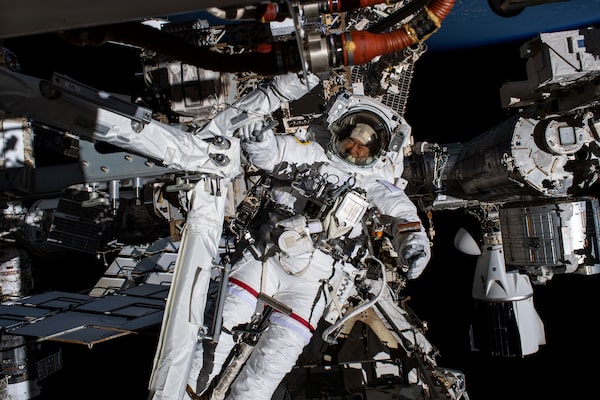
Akihiko Hoshide, an astronaut with the Japanese space agency JAXA, spacewalks outside the International Space Station on Sept. 12, 2021. The spacewalk was captured in virtual reality by Felix and Paul studios for an upcoming episode of their multiplatform series, Space Explorers: The ISS Experience.NASA/NASA
Communing with the infinite while floating high above the Earth is an experience that, so far, has been known to only a handful.
Now, a Montreal production company aims to share that experience with audiences around the world, following the first ever recording of a spacewalk in the medium of virtual reality.
“It’s something that has absolutely never been done before,” said Félix Lajeunesse, co-founder and creative director of Felix and Paul studios, which developed the project in partnership with TIME Studios and NASA.
“The spacewalk is something that I’ve dreamt about for years and … we have worked for every week heading to that moment,” he said.
The company, which specializes in creating virtual-reality experiences with cinematic flair, got its long-awaited chance in mid-September when astronauts Thomas Pesquet and Akihiko Hoshide ventured outside the International Space Station for about seven hours to install supports and other equipment in preparation for a new solar array.

Space Explorers: The ISS Experience is different from earlier space documentaries about life aboard the station in that virtual reality allows audience members to look around in any direction.Felix & Paul Studios and TIME Studios/Courtesy of Felix & Paul Studios and TIME Studios
The footage will be used in the fourth and final instalment of Space Explorers: The ISS Experience, a virtual-reality journey to space that has already garnered a Primetime Emmy Award for its first two episodes.
From the outset, the production was developed to reach audiences through a variety of platforms for 360-degree viewing, including 5G-enabled smart phones and tablets. A domed theatre version of the experience for group audiences opened this week at the Rio Tinto Alcan Montreal Planetarium. Those who desire a more immersive experience can now see the first two episodes in VR form by using a headset available through the gaming and entertainment company Oculus. Scenes from the VR series are also on offer as part of The Infinite, an interactive exhibition developed by Montreal’s Phi Studio, whose works focus on the intersection of art and technology. The exhibition, which runs until Nov. 7, has attracted 40,000 visitors since it opened in July.
“This is probably as close as you’ll ever be to going to the space station,” said Myriam Achard, PHI’s chief of new media partnerships. She said that the final part of the VR experience includes an opportunity to gaze down at the Earth from space as though from the cupola – the space station’s main viewing area.
“It is a very powerful moment,” she said, adding that some visitors have been brought to tears by the experience.

The company made its initial pitch to NASA in 2016 and gradually built confidence in its ability to tackle the project.Felix & Paul Studios and TIME Studios/Courtesy of Felix & Paul Studios and TIME Studios
At a time when billionaires are able to head off on private extraterrestrial sojourns that almost no one else could dream of, Lajeunesse said his project was developed with a very different purpose in mind: making it easier for audiences to become eyewitnesses rather than distant spectators to humanity’s greatest adventure.
“The concept was always to create a bridge, through technology and through media, to allow people to experience a glimpse of what it feels like [to be on the space station]. That remains the whole point,” he said.
There were plenty of challenges on the way to the launch pad.
The company made its initial pitch to NASA in 2016 and gradually built confidence in its ability to tackle the project while filming astronauts in training at the Johnson Space Center in Houston and at the Russian Space Agency’s training site near Moscow. The company also filmed at the Baikonur Cosmodrome in Kazakhstan, which, until recently, was the departure point for all astronauts heading to the space station.
To take the next step – following crews into orbit – the Montreal company needed to adapt its equipment to meet the strict specifications required by NASA and to enable filming in the vacuum of space. Since the filmmakers could not be on hand to man the equipment themselves, astronauts also had to be enlisted and trained as VR camera operators aboard the station.
“We were willing to undertake those efforts because we know how valuable this production is,” said Jessica Meir, a U.S. astronaut who was involved in filming for the project during a seven-month stint on the station starting two years ago. “It’s really such a unique platform.”
She added that, after watching the results, she found the experience so immersive that it could be used in training to help acclimatize astronauts to the three-dimensional environment of the station, a place with no up or down in the conventional sense, before journeying there.
The feeling was echoed by Canadian astronaut David St. Jacques, who contributed to the filming during his 204 days on the station in 2018-19, the longest Canadian space mission to date.
The crucial spacewalk shoot for Space Explorers: The ISS Experience was planned for early this year but technical problems intervened and for a time it was not clear if or when another chance might arise.Felix & Paul Studios and TIME Studios/Courtesy of Felix & Paul Studios and TIME Studios
What makes Space Explorers: The ISS Experience different from earlier space documentaries about life aboard the station is that virtual reality allows audience members to look around in any direction they choose, rather than be led by a director’s selection of shots. St. Jacques said that viewers may be surprised not just by the exotic nature of the location but by the sense of intimacy that the experience achieves by putting the audience in proximity with crew members during daily activities, such as sharing a meal.
“There’s no backstage. Everything’s on stage,” he said. “This is one of the most candid things that’s ever been filmed in space.”
For the final instalments, the storyline takes viewers outside of the space station with cameras mounted on the Canadarm, and – for the climax of the series – by following astronauts during a spacewalk. These scenes required extensive planning, not only because of the limited time frame in which they could be gathered, but because of the lighting challenges presented by a constantly shifting sun as the space station circles the globe once every 90 minutes.
The crucial shoot was planned for early this year but technical problems intervened and for a time it was not clear if or when another chance might arise. By the time the opportunity arose again in September it was with a different crew. Fortunately for the filmmakers, the spacewalkers were assigned a task similar to what the production company had originally planned for.
“We were lucky because a lot of the work that we had prepared for the first attempt – in terms of camera choreography and in terms of calculating where to be at what moment in time – a lot of that could be applied to the new filming opportunity,” Lajeunesse said.
But Lajeunesse said that it was equally important to acquire shots that are not just technically spectacular but that serve the underlying themes of Space Explorers: The ISS Experience. These include an examination of human adaptation and advancement, and the unity that emerges within a group of individuals from many places and cultures and who must learn to co-exist in a high risk environment in order to achieve a common goal.
During the spacewalk Lajeunesse and his team were able to download low resolution stills of the unfolding footage, which provided a sense of what they were capturing. But he said he was still astonished when the VR footage began arriving during the following days.
“It’s mind blowing,” he said when describing the fully immersive view of the station, the crew and the planet all at once in a VR environment. “It almost feels like something that evolution did not prepare us to look at.”
In the coming weeks the footage will be used to complete the series and augment The Infinite, when the exhibition begins travelling internationally later this year.
But Lajeunesse said he isn’t ready to come back to Earth any time soon. As NASA and its international partners, including Canada, move toward a joint effort to bring humans to the moon, he said that the potential for virtual reality to document years of lunar exploration is too great not to pursue.
“We want to be part of that,” he said. “We’re not astronauts but we’re filmmakers. We develop the tech that enables us to tell those stories … and we have a lot of work to do.”
Sign up for The Globe’s arts and lifestyle newsletters for more news, columns and advice in your inbox.
 Ivan Semeniuk
Ivan Semeniuk